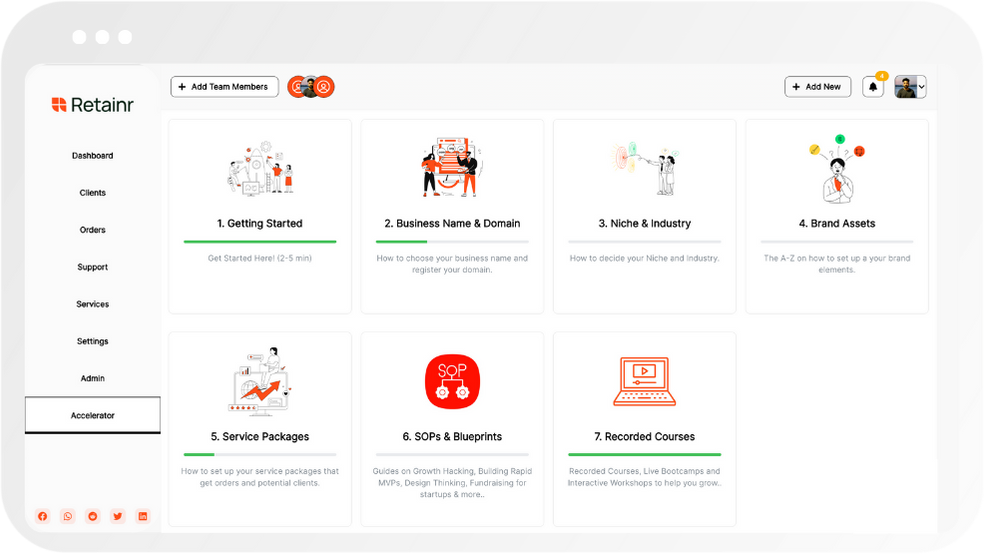
7 Game-Changing Digital Tools for Business Growth in 2024
Build with Retainr
Sell your products and services, manage clients, orders, payments, automate your client onboarding and management with your own branded web application.
Get Started1. What are the top 7 digital tools expected to drive business growth in 2024?
The Top 7 Digital Tools Expected to Drive Business Growth in 2024
In the rapidly changing digital world, having the right tools can redefine the growth trajectory of businesses. As the year 2024 approaches, let's explore the top seven digital tools anticipated to drive business growth.
Cloud Computing Platforms
Cloud computing platforms like Microsoft Azure, Google Cloud, and Amazon Web Service are projected to be important tools for businesses in 2024. They offer scalable and cost-effective solutions for storing and processing data, alongside AI and Machine Learning capabilities.
Artificial Intelligence Tools
As AI continues to mature, tools such as TensorFlow, IBM Watson, and Keras are likely to be crucial in developing AI-driven solutions for businesses. These tools provide capabilities for speech recognition, natural language processing, and predictive analytics.
List of 7 Game-Changing Digital Tools
| Sl.No | Digital Tool | Key Benefit |
|---|---|---|
| 1 | Cloud Computing Platforms | Scalable and cost-effective data storage and processing |
| 2 | Artificial Intelligence Tools | New capabilities for speech recognition, NLP, and predictive analytics |
| 3 | BIGDATA Platforms | Handling large volumes of structured and unstructured data |
| 4 | Customer Relationship Management Software | Increased customer loyalty through better service management |
| 5 | Project Management Platforms | Better team collaboration and project tracking |
| 6 | Social Media Management Tools | Effective management of multiple social media channels |
| 7 | Cyber Security Tools | Enhanced defense against growing cyber threats |
The above-listed digital tools promise to bring in novel trends in business operations and deliver enhanced outcomes in 2024. Businesses should thus leverage these forefront techs to ensure growth and profits in the coming years.
2. How can these digital tools contribute to business growth in 2024?
Role of Digital Tools in Business Growth
Digital tools can play a pivotal role in achieving business growth in 2024. They enhance productivity, improve customer service, and facilitate better decision-making. To understand how this happens, let's discuss some points:
- Enhanced productivity: Businesses can leverage digital tools to augment productivity. For instance, project management tools can help in tracking and managing tasks efficiently, which can result in reduced operational time and costs. Moreover, digital marketing tools can streamline your marketing campaigns, ensuring they target the right audience and thus, increasing your conversion rate.
- Better customer service: Digital tools like CRM software can help businesses understand their customer needs and preferences better. This can result in personalized services, higher customer satisfaction, and loyalty, which are key to fostering business growth.
- Informed decision-making: Tools like data analytics software can provide businesses with insightful data, enabling them to make informed strategic decisions. Furthermore, AI-powered tools can forecast trends, detect patterns, and issue timely alerts, which can help businesses stay ahead of the competition.
Real-World Examples of Digital Tools for Business Growth
Several digital tools have proven to be game-changers for businesses worldwide. Here are some examples:
| Digital Tool | Use Case |
|---|---|
| HootSuite | HootSuite, a social media management tool, helps businesses manage their social media content on multiple platforms from a single dashboard, thus increasing their social media presence and engagement. |
| Slack | Slack, a team collaboration tool, enhances communication within teams, thus resulting in improved project management and productivity. |
| Salesforce CRM | Salesforce CRM provides businesses with a comprehensive view of their customers, allowing them to deliver personalized services and improve customer experience. |
The Future of Business Growth in 2024 and Beyond
As we look ahead to the future, it's clear that digital tools will remain key drivers of business growth in 2024 and beyond. They will continue to evolve, offering companies innovative ways to meet their strategic business objectives. Here are some future trends:
- Artificial Intelligence (AI): AI will become more integrated into digital tools, making them more powerful and efficient.
- Automation: More processes will be automated, making businesses more productive and cost-effective.
- Data-driven decision-making: Businesses will rely even more heavily on data analytics to make strategic decisions.
Therefore, companies that prioritize digital transformation will be best positioned to drive business growth in the coming years.
3. What features set these 7 digital tools apart from the rest in promoting business growth?
Distinctive Features of the 7 Digital Tools
The 7 digital tools bringing about game-changing strategies in business growth are not the typical ones you encounter; their distinction lies in their features. These features are specially curated to enhance aspects such as collaboration, real-time analytics, customer outreach, and business automation. Here's a glimpse into what sets them apart:
- Real-time Analytics: This feature provides your organization with real-time data related to your business performance across multiple channels. This instant availability of data ensures you can make quick decisions that positively impact your business growth.
- Scalability: As your business grows, so will your needs. These tools are designed to scale in order to efficiently handle the increasing workload. This enables you to focus on growth while the tool takes care of the rest.
- Automation: Time is a precious resource in business. By automating repetitive tasks, these tools save you time that can be invested in more valuable activities, contributing to business growth.
Impact of the Digital Tools on Business Growth
The unique features of these digital tools enable businesses to take on a more data-driven and efficient approach. The table below provides a detailed look into how these features translate into promoting business growth:
| Feature | Impact on Business Growth |
|---|---|
| Real-time Analytics | Enables data-based decision-making that captures market trends and helps stay ahead of competitors |
| Scalability | Adapts to the increasing demands of the growing business without requiring additional resources |
| Automation | Reduces workload while increasing efficiency, freeing up resources to focus on revenue generating operations |
Thinking Ahead with the Right Tools
The chosen digital tools owe their game-changing status to these set-apart features. When selecting a digital tool for your business, consider the ability of the tool to provide real-time analytics, the scalability to your ever-growing needs, and the kind of automation it offers. These attributes are the key to propelling your business towards greater heights in the modern corporate world.
4. How can a business implement these 7 digital tools in their operations for optimal growth?
Implementation of Digital Tools
To appropriately implement the identified seven critical digital tools for business growth, the following steps can be adopted:
- Develop a Digital Strategy: First, organizations need to have a clear digital strategy. This strategy should align with the overall goals of the organization. The strategy should clearly identify the roles of each digital tool, how it contributes to the organization's growth, and the metrics for measuring its success.
- Training and Development: Businesses must invest in training their employees on how to use these tools effectively. Several providers offer comprehensive training programs that can be delivered online or in-person. It is also critical that this training is an ongoing process to keep up with the continuous evolution of digital tools.
- Continuous Review and Improvement: Once the digital tools are implemented, their effectiveness and efficiency should be reviewed regularly. Performance data should be collected and analyzed to identify areas of improvement. This will not only help improve the performance of the tool but will also contribute to the overall growth of the business.
Integration with Existing Systems
Each tool should be effectively integrated with the existing systems for optimal performance. For instance:
- Email marketing software can be integrated with the CRM system to automate the customer contact process.
- Project management tools can coordinate with existing workflow and communication systems to ensure seamless collaboration within the team.
- Analytics tool should work in synergy with other digital systems to collect and analyze data accurately.
Use Cases - Implementing Digital Tools
Here are some scenarios illustrating how incorporating these digital tools can boost business growth:
| Digital Tool | Use Cases |
|---|---|
| Email marketing software | Automating follow-up emails after customer interactions, sending promotional messages, and newsletters. |
| Project management tools | Organizing team tasks and communication, tracking project progress, and managing resources. |
| Analytics tool | Tracking website and social media performance, customer behavior, and market trends. |
5. What industries are these digital tools best suited to for business growth in 2024?
Best Suited Industries for Digital Tools in 2024
By 2024, numerous industries are projected to harness the full potential of these game-changing digital tools for their business growth. The diversity of these tools ensures a wide range of applications in various sectors.
- Information Technology and Software Development: These industries are at the forefront of technological advancements due to the nature of their work. Tools like automation software, cloud computing platforms, and project management tools are vital.
- E-commerce and Retail: Digital tools like CRM systems, chatbots for customer service, and AI-driven personalization tools can drastically improve user experience and operational efficiency.
- Healthcare: Digital tools such as telemedicine platforms, AI diagnostic tools, and electronic health record systems facilitate efficient and quality patient care.
Benefits and Implementation of Digital Tools per Industry
The table below illustrates the industries highlighted above, the corresponding digital tools, and the business growth benefits they prospective offer.
| Industry | Digital Tool | Business Growth Benefit |
|---|---|---|
| Information Technology and Software Development | Cloud Computing Platforms, Automation Tools | Increased efficiency and cost-saving |
| E-commerce and Retail | CRM systems, Chatbots | Improved user experience, Increase in sales |
| Healthcare | Telemedicine platforms, Diagnostic Tools | Enhanced patient service, cost efficiency |
Anticipated Shifts in Industry Tool Use
It's important to bear in mind that the industries listed above are not the sole beneficiaries of these digital tools. As we move towards 2024, it's anticipated that industries such as Education, Finance, Manufacturing and more, will increasingly leverage these tools for astounding business growth.
- Education: Learning management systems, virtual reality tools, and student management systems have been facilitating remote learning rapidly.
- Finance: AI-based robo-advisors, blockchain technologies, and big data analytics tools have facilitated efficient operations and improved financial service delivery.
6. How cost-effective are these 7 digital tools in fueling business growth?
Cost-Effectiveness of the 7 Digital Tools
Investment in digital tools for business growth should guarantee a high return on investment. The seven digital tools mentioned previously are quite cost-effective in fueling business growth. Cost-effectiveness determines the economic viability of these digital tools by comparing their costs and impacts on business growth.
- Customer Relationship Management (CRM) Software: Advanced CRM software organizes customer data that you can use for targeted marketing strategies. The cost of CRM software varies, but the long-term benefits in customer retention and acquisition far outweigh the costs, making it a cost-effective choice.
- Content Management Systems (CMS): CMS like WordPress and Wix provides businesses with user-friendly platforms for managing digital content. While there's an initial setup cost, the ease of use and vast functionality create saving in the long-term.
- Analytics Tools: Google Analytics and other such tools provide insight into customer behavior, which is invaluable for driving business growth. Although some packages may appear costly, the detail of insight into your operations makes it worth every cent.
- Email Marketing Tools: While quite affordable, these tools also offer an impressive ROI. Statistics suggest that email marketing has an average ROI of 3800%.
- Search Engine Optimization (SEO) Tools: SEO tools might require a significant investment, but the organic traffic driven to your site provides long-term, sustainable growth for your business.
- Social Media Scheduling Tools: Although minimal in cost, these tools save a considerable amount of time, thus enhancing productivity in other areas of your business.
- Project Management Tools: These tools minimize the margin for errors and enhance productivity, making the cost per user per month quite minimal compared to the benefits.
Cost-Benefit Analysis
Below is a table showing the approximate costs and impacts of each digital tool on business growth. These are approximations and may vary depending on the specific tool and its use in your unique business context.
| Digital Tool | Approximate Cost per month | Impact on Business Growth |
|---|---|---|
| CRM Software | $50-$300 | High |
| CMS | Free-$300 | Medium |
| Analytics Tools | Free-$200 | High |
| Email Marketing Tools | $20-$500 | High |
| SEO Tools | $30-$100 | High |
| Social Media Scheduling Tools | $10-$150 | Medium |
| Project Management Tools | $5-$150 | High |
7. Can small businesses benefit from these 7 digital tools for growth in 2024?
Benefits of Digital Tools for Small Businesses
Small businesses stand to glean substantial benefits from the seven digital tools projected to drive business growth in 2024. Leveraging these tools enables small firms to optimize operations, streamline workflow, save time and cost, enhance customer experience, and bolster brand visibility. Thus, they become more competitive and set the stage for sustainable growth.
- Productivity Tools: Tools like project management software allows small businesses to track project progress, delegate tasks, and enhance overall productivity.
- Social Media Management Tools: These tools help in crafting and scheduling content, managing multiple accounts, and analysing social media analytics for targeted marketing.
- SEO Tools: SEO tools are crucial in enabling small business websites to rank higher in search results, enhancing visibility and attracting more potential customers.
Digital Tools and Business Efficiency
By incorporating digital tools, small businesses improve their efficiencies in several ways.
| Digital Tools | Benefits |
|---|---|
| Email marketing software | Allows businesses to reach a large audience at a low cost. |
| Customer Relationship Management systems | Helps manage customer data, track sales, and improve customer service. |
| E-commerce platforms | Fosters online sales and extends business's reach. |
Digital Tools for Business Growth and Profitability
Small businesses, in particular, have a lot to gain from digital tools and technology. It not only enhances their operational performance but also significantly impacts their growth metrics and profitability.
- Data Analytics: It helps in gathering insights about customer behaviour, product performance, and market trends which aids in decision making.
- Communication and collaboration tools: These improve communication, promote team collaboration, and hence boost productivity.
- Financial Management Tools: These tools make it easier to track expenditures, manage invoices, payroll, and other financial operations, reducing errors and saving resources.
8. Are there specific case studies showcasing how these digital tools can drive business growth?
Case Studies Showcasing the Impact of Digital Tools on Business Growth
Digital tools hold great potential to facilitate business growth, and numerous case studies back up this claim. Two areas where digital tools have shown notable promise include customer communication and operational efficiency.
Customer Communication Case Study: AirAsia
One company that has leveraged a digital tool to enhance its customer service is AirAsia. They utilized the Intercom platform, a chatbot and messaging tool, to improve real-time communication with customers, smoothen the booking process and provide instant customer service. As a result:
- Their average handling time dropped by 60%
- They achieved a customer satisfaction rate of 87.5%
- The volume of inquiries they were able to handle increased by 170%.
Operational Efficiency Case Study: Caterpillar
For Caterpillar, the leading manufacturer of construction and mining equipment, incorporating digital tools in its operation was key to upscaling productivity. They used drones equipped with the DroneDeploy application to map job sites, track assets and equipment, monitor progress and even identify safety hazards. This implementation led to:
- An 85% reduction in the time spent to conduct job site inspections
- A 3-5X more frequent data capture which enhanced the accuracy of their insights
- Significant cost savings
| Company | Digital Tool | Outcome |
|---|---|---|
| AirAsia | Intercom platform | Increased customer satisfaction and operational efficiency |
| Caterpillar | DroneDeploy | Improved safety, timesavings, and cost reduction |
9. What potential challenges may businesses face when integrating these digital tools into their operations?
Potential Challenges in Integration of Digital Tools
Although it is true that new digital tools can work wonders for a business, integrating these technologies into existing systems is not without its fair share of challenges. The difficulties might range from understanding the technology itself, to revamping business processes and securing user adoption.
Here are some of the potential challenges businesses might face:
- Technical Understanding: Digital tools are often complex and utilizing them to their full potential requires a thorough technical understanding. Technical glitches during the integration process could lead to inefficiencies and downtimes.
- Employee Training: It is crucial that all employees understand how to use the new tools. This often requires intensive training and change management efforts.
- Integration with Existing Systems: The new digital tool must be compatible with existing software and hardware.
- Securing User Adoption: Employees may resist change due to the fear of the unknown. They usually prefer to stick with the systems they are comfortable with.
- Cost: Apart from the cost of the digital tool itself, businesses may need to invest in upgrading their infrastructure, training employees or hiring new specialists.
Digital Tools Integration Challenges Table
| Challenges | Impacts |
|---|---|
| Technical Understanding | Can lead to inefficiencies and downtimes due to technical glitches during the integration process. |
| Employee Training | Employee productivity and system usage might be low due to lack of proper understanding. |
| Integration with Existing Systems | Potential compatibility issues with existing software and hardware; may require further adjustments or modifications. |
| Securing User Adoption | Resistance to change and attachment to familiar systems can slow down the pace of integration and adoption. |
| Cost | High upfront investment for upgrading infrastructure, training, or new hires may be necessary. |
10. How can businesses ensure they are fully leveraging these 7 digital tools for maximum growth in 2024?
Understanding Tools for Optimum Utilization
For every business to fully leverage the potential of the 7 digital tools, having a clear understanding of their functionality and how it applies to the business is paramount. First, you need to establish what these tools offer and how these features align with your business objectives. For example, if you have a tool that supports automation, you need to first understand the processes that are repetitively being performed manually and how they can be automated using the digital tool. This way, your business can enjoy more efficiency and higher productivity. Moreover, frequent training and seminars should be organized for employees to better understand these tools.
Integration and Consolidation of Tools
To get the most out of these tools, businesses should consider having a streamlined workflow where each tool seamlessly integrates with the other. In that case, the output from one tool can be conveniently utilized as an input to another tool. This will foster a faster and more efficient work flow.
| Tool | Integration |
|---|---|
| Tool 1 | Fully integrated into employee's daily workflow for productivity |
| Tool 2 | Integrated with other tools to consolidate data and insights |
This strategy reduces the time and effort it takes to transfer information or processes from one tool to the other. However, it is important to regularly monitor and ensure that the integration processes are updated as required for optimum functionality.
Continuous Evaluation and Feedback
Ultimately, constant evaluation of the performance of these tools can help determine if their full potential is being harnessed. Regularly check their performance against your set expectations and note any gaps or inhibitions to maximum performance. Employees, being the actual day-to-day end-users of these tools, should be encouraged to provide feedback and suggestions on how these tools can be better improved to match their work needs. This way, businesses can ensure they are fully leveraging these 7 digital tools for maximum growth in 2024.
Conclusion
```htmlEmbrace the Digital Revolution for Business Growth
In the dynamic business world, leveraging digital tools has become imperative to expedite growth and success. Tools that streamline management, payments, client relations, and order handling have seen a rise in popularity.
In the Eye of the Revolution: Retainr.io
One such game-changing software is Retainr.io. A whitelabor software, Retainr.io is your one-click solution to managing clients, overseeing orders, processing payments, and even selling your products or services. What sets it apart, is the ease of setting your own branded app, giving a personalized touch to your business operations.
The Advantage of Retainr.io
Adopting Retainr.io can redefine your business dynamics. It aids in strengthening your brand's identity, simplifying business operations, and enhancing the overall customer experience. The white-label element adds a unique touch of sophistication, setting your brand a class apart.
Conclusion
Choosing the right digital tool can prove to be the turning point for your business. As we look towards 2024, utilizing innovative tools like Retainr.io is not just an option, but a powerful requirement for a prosperous and growth-centric future.
```Boost Your Agency Growth
with Retainr Accelerator
Uncover secrets, strategies, and exclusive blueprints to take your agency's growth to the next level — from marketing insights to effective presentations and leveraging technology.

SOPs, Cheatsheets & Blueprints
Leverage 50+ SOPs (valued over $10K) offering practical guides, scripts, tools, hacks, templates, and cheat sheets to fast-track your startup's growth.
Connect with fellow entrepreneurs, share experiences, and get expert insights within our exclusive Facebook community.
.jpg)

Join a thriving community of growth hackers. Network, collaborate, and learn from like-minded entrepreneurs on a lifelong journey to success.

Gain expertise with recorded Courses, Live Bootcamps and interactive Workshops on topics like growth hacking, copywriting, no-code funnel building, performance marketing and more, taught by seasoned coaches & industry experts.

.jpg)

.jpeg)


